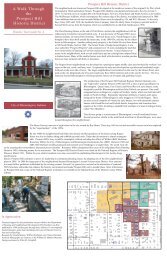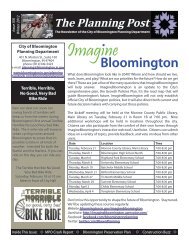Peak Oil Task Force Report - City of Bloomington - State of Indiana
Peak Oil Task Force Report - City of Bloomington - State of Indiana
Peak Oil Task Force Report - City of Bloomington - State of Indiana
You also want an ePaper? Increase the reach of your titles
YUMPU automatically turns print PDFs into web optimized ePapers that Google loves.
4. Add an Activity Nodes overlay to the UDO.<br />
In the interest <strong>of</strong> ultimately providing all neighborhoods with essential services within<br />
walking distance, the <strong>City</strong> should start with a nodal development overlay as a pilot.<br />
Standards for such an overlay should be structured to foster the essential characteristics <strong>of</strong><br />
pedestrian‐friendly, human scale development:<br />
• Design elements that support pedestrian environments and encourage<br />
transit use, walking, and bicycling;<br />
• Transit access within walking distance (generally ¼ mile) <strong>of</strong> anywhere<br />
within the node;<br />
• Mixed uses and a commercial core so that essential services are within<br />
walking distance;<br />
• Parks and other public and private open spaces within walking distance; and<br />
• A mix <strong>of</strong> housing types and residential densities.<br />
5. Implement regional planning: Toward a Unified Comprehensive Land Use and<br />
Transportation Plan.<br />
As we revise the use <strong>of</strong> the existing built environment, we must simultaneously plan for the<br />
shape <strong>of</strong> the future built environment. In a post‐peak era, we should be aiming for<br />
development patterns that lead to higher population density in areas designated as activity<br />
nodes, and that foster mixed use, walking, biking, and transit use. (See Transportation<br />
chapter). Right now, transportation planning is largely separate from land use planning<br />
and land use planning is a largely self‐contained effort: <strong>Indiana</strong> University, Monroe County,<br />
and the <strong>City</strong> <strong>of</strong> <strong>Bloomington</strong> all draft and implement their plans independent <strong>of</strong> each other.<br />
Without coordinated planning, there is little hope for a comprehensive vision to guide<br />
development as transportation fuels become more expensive and are not as readily<br />
available. However, such cooperation is precisely what is called for in the <strong>City</strong>’s GPP. The<br />
GPP directs the <strong>City</strong> to “[s]tudy the feasibility <strong>of</strong> creating a consolidated planning<br />
department for the <strong>City</strong> and County as a method <strong>of</strong> improving planning and development<br />
management .” 140<br />
140 2002 Growth Policies Plan, Implementation Measure ACC‐3, p. 22.<br />
https://bloomington.in.gov/media/media/application/pdf/49.pdf<br />
<strong>Report</strong> <strong>of</strong> the <strong>Bloomington</strong> <strong>Peak</strong> <strong>Oil</strong> <strong>Task</strong> <strong>Force</strong><br />
105









